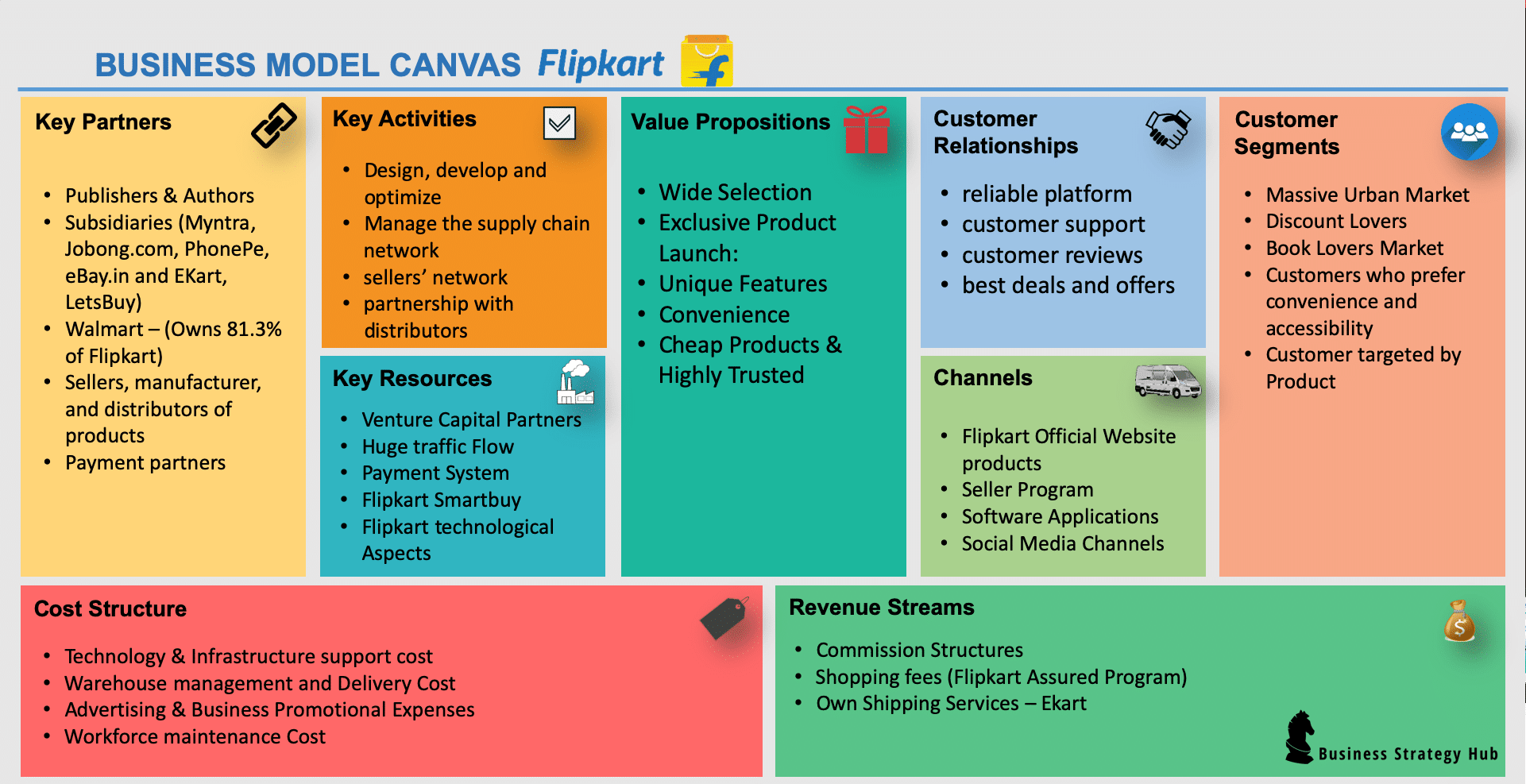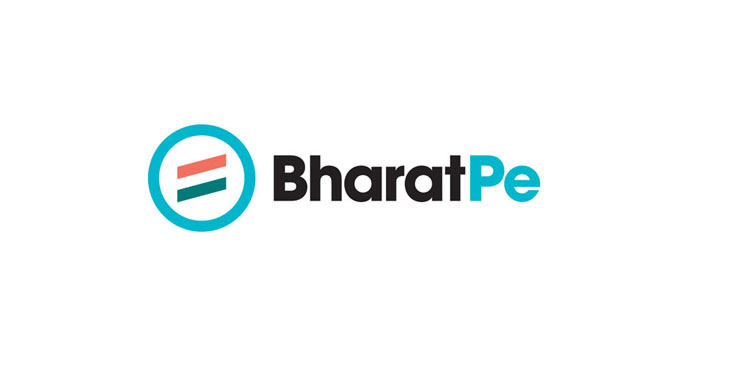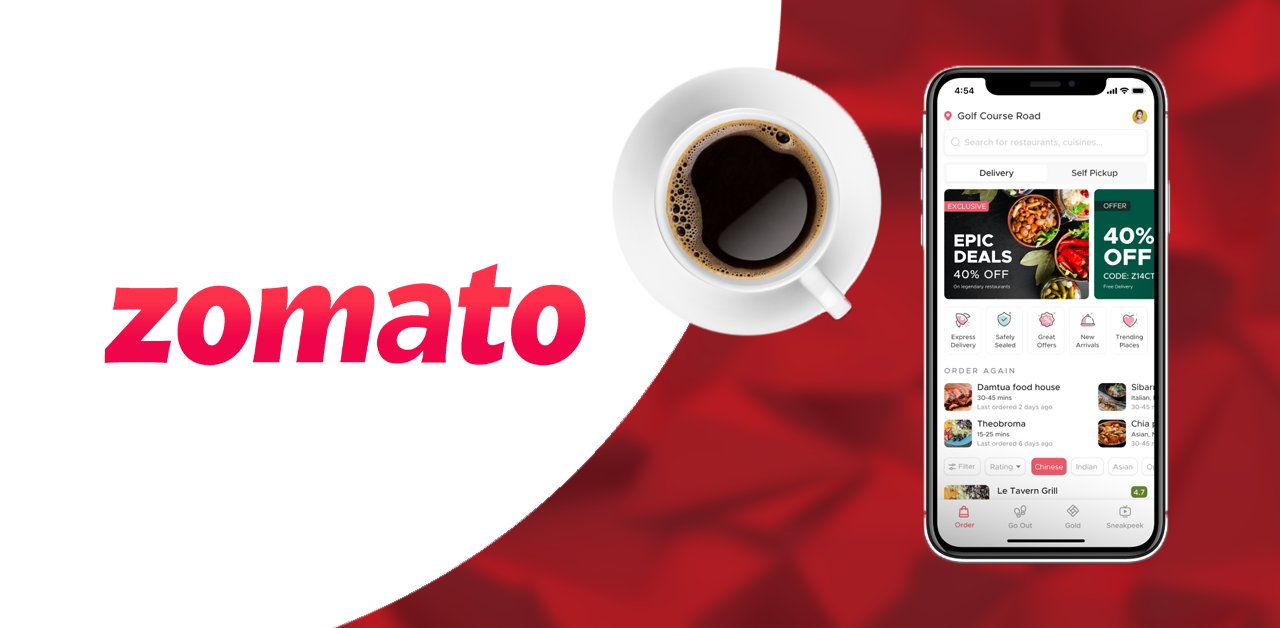Introduction
Flipkart has the top score of the most visited e-commerce websites and just like Amazon, the business has promptly enhanced one of India’s innovative unicorns. Its business plan involves its market share, product offering, Target audience, Investor, and Competitor advantage.
Flipkart is India’s leading e-commerce company headquartered in Bengaluru. Sachin Bansal and Binny Bansal are the founders of India-based Flipkart in 2007. Flipkart has a wide variety of products online. Now owned by Walmart, the company is one of the great success stories of India.
With over 80 categories, Flipkart has sellers for all items, ranging from groceries, toiletries, clothes, books, shoes, furniture, electronics, etc.
Business Model Canvas

Timeline of Flipkart
- Phase 1 was the foundational phase between 2008 and 2014. Flipkart initially focused on selling books, building India-wide distribution network, and providing great customer experience to early adopters of the service. After cracking that, Flipkart expanded to electronics in 2011 and acquired Myntra in 2014. Flipkart held its first Big Billion Day sale in 2014.
- Phase 2 was the intense competition phase. Amazon launched its marketplace in India in 2013 and, in 2014, announced that it will invest at least $2B to grow its footprint in India. So, the race to dominate Indian e-commerce started in earnest in 2014. Between 2015 and 2017, there was an intense fight between Flipkart and Amazon.

- Phase 3: By early 2018, it was becoming clear that Flipkart would be able to hold its ground against the much larger and much stronger competitor. This led to the consolidation phase for Flipkart. In this phase, it was important for Flipkart to strengthen its lead and to ensure that the advantage does not slip away.
Revenue model of Flipkart
Flipkart works on a B2C model, where they basically work as a middle man between buyers and sellers. To make revenue, they charge a commission, a convenience fee, logistic charges, advertisement charges, Myntra as only some of the areas they generate revenue from.
SWOT Analysis
Flipkart is an online B2C shopping portal, which provides shopping opportunities to Indian consumers. It allows the vendors to sell their ready-to-sell products by giving appealing discounts or sales to its consumers who wish to buy them. The buyers choose the products they want and place an order and they are shipped to them.
The various options for selling and buying through Flipkart are through
- Flipkart website
- The web app
- Social websites
- Advertised or affiliated networks like review websites, coupon websites, bloggers, etc.
The percentage commission charged by Flipkart varies from the type of product and its sales. It ranges from 5% to 20% excluding taxes and discounts. This was the basic idea from which Flipkart earned its online place.
Flipkart operates on the B2C model (Business-to-Consumer).

SWOT Analysis of Flipkart focuses on Strengths, weaknesses, opportunities, and threats. Strength and Weaknesses are internal factors and Opportunities and Threats are the external factors that influence the SWOT Analysis of Flipkart.
Strength in the SWOT Analysis of Flipkart
- Large Company: Flipkart is India’s largest e-commerce company, with a GMV (gross merchandise value) of $1 billion.
- Market Share: Flipkart has a market share of 39.5%.
- Financials: Flipkart has annual revenue of 6.1 billion US Dollars.
- Acquisitions: The Company’s series of acquisitions, including chakpak.com, weread.com, Letsbuy.co, Mine360, and Myntra, has assisted the company in its expansion into the E-commerce space by leveraging the capabilities and existing resources of acquired companies.
- High brand recall: Flipkart has established itself as a renowned E-commerce company in India through television advertisements, online branding, and its presence on social media platforms. Brand activities such as the “Big billion day” have significantly increased the company’s brand recall.
- Own Payment Gateway & Logistics Arm: Having its own Logistics arm is advantageous. The company has been able to control its expenses through E-kart and the payment gateway Payzippy. As a result, the benefits are passed on to the end users.
- Exclusive and broad product range: Having exclusive rights to launch some products, such as Motorola Mobiles, Xiaomi Mobiles, Oppo, Vivo, and personal designers segments in the garments category, has helped the company differentiate and localise its offerings.
- Brand Portfolio: Flipkart has built a strong portfolio of brands. The SWOT analysis of Flipkart clearly confirms this element. This organization’s brand portfolio can be extremely useful for them if they want to enter new product lines.
- Launch New Products: Highly regarded when it comes to launching the new products.
- Good ROI: Flipkart is relatively successful at the execution of new projects and it generates good profits through its existing business. Company is generating good Return on its investments.
- Good Promotional Income: Flipkart charge extra for promoting products of its seller. This model always is beneficial for the company.
- Large Employee Base: Flipkart has an employee base of 30,000+ employees.
- Good Training and Development Programmes for its Employees: High level personal skills can be acquired through training and development programmes. Flipkart is providing continuous training and development of its employees resulting in an enthusiastic and motivated team.
- India’s Largest E-commerce Retailer: Flipkart is the India’s largest E-commerce company & had sold GMV (gross merchandising value) of $1 billion till now.
Weaknesses in the SWOT Analysis of Flipkart
- Limited Distribution: Flipkart has a limited distribution channel reach, despite the fact that its logistics arm has kept costs low. This is a weakness for the company, as it has limited reach. Because of the use of outsourcing, global giants such as Amazon and eBay are able to deliver their products to any location in the country. Flipkart, on the other hand, is still struggling in this area.
- Cost of Acquisition: Due to stiff competition in the market & low customer retention, the cost of Acquisition is high because Flipkart acquires a lot of customers through online advertising. As per Flipkart data, the company spends R.s 400/- on acquiring a new customer on an average.
- Power in the hand of buyers: Since this industry is flooded with many players, buyers have a lot of options to choose. Switching costs are also less for customers since they can easily switch a service from one online retail company to another. Same products will be displayed in several online retail websites. Product differentiation is almost absent and the fight then begins on the basis of price only.
Opportunities in the SWOT Analysis of Flipkart
- Expanding product categories: This will increase their customer base while decreasing the cost of acquisition and customer switch.
- The changing mentality of Indian customers: As an increasing number of customers become more comfortable with online shopping, as well as an increase in the number of Internet users in India, there is tremendous opportunity in this industry.
- Supply chain: By optimizing their supply chain, they can compete with the other players and manage the sales that are lost as a result of not being able to make the product available due to delivery constraints.
- Establishing operations in other developing economies: Similar to Amazon, Flipkart can gradually begin to expand its operations outside of India and establish operations in other countries as well, which will aid in the growth of its revenues.
- Consumer Behavior: The new trends in consumer behaviour will open up new opportunities for Flipkart. This has given a great opportunity for the organization to expand revenue streams and to diversify into new product categories.
- Expansion of business: By targeting other emerging markets company can increase their revenues as well as it can have Economies of scale.
Threats in the SWOT Analysis of Flipkart
- Government Regulations: The government’s regulations on issues such as foreign direct investment (FDI) in multi-brand retail have posed a significant barrier to the growth of the E-commerce industry in India.
- Competition: Stiff competition from the global players like Amazon, eBay as well as local player like Snapdeal, Tolexo and Shopclues who are continuously trying to eat each other’s market share.
Conclusion
Being India’s largest e-commerce platform it operates on a B2C business model by providing services related to the online book store and some other products. After it expanded into other sectors and became an e-commerce company, Flipkart shifted to a business-to-consumer model. Flipkart’s business model joins dealers and purchasers on its platform.




